Louisiana Sea Grant lends a helping hand to New York and New Jersey Sea Grant
—
Compiled and Published By National Sea Grant Office
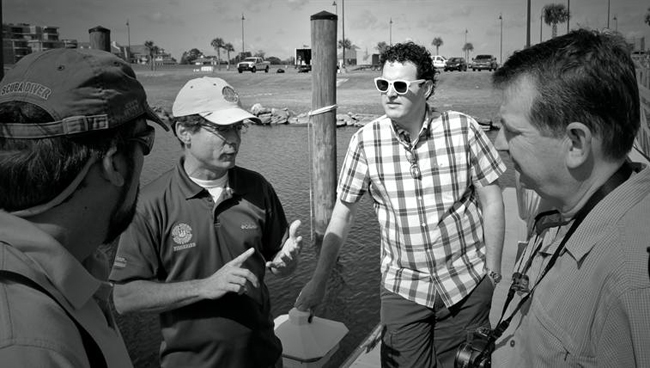
Washington, D.C., July 17, 2014—More than a year and a half after Hurricane Sandy made landfall in the northeast, the Sea Grant programs in New Jersey, New York and Connecticut are still dealing with storm recovery issues – ranging from community resilience and flood insurance to impacts on recreational fisheries and marina reconstruction. In the nearly nine years since Hurricanes Katrina and Rita, Louisiana Sea Grant has addressed many of the issues Sandy survivors continue to face and may have to manage for years to come.
“Although we offered assistance immediately after Sandy made landfall in October 2012, we realized there’s more we could do for our sister programs as they trek down the long recovery road,” said
Rex Caffey,
Louisiana Sea Grant and LSU AgCenter Marine Extension leader. “We not only have experience with recovery from Katrina and Rita in 2005, we also had Hurricanes Gustav and Ike in 2008, as well as Hurricane Isaac in 2012.
“We saw an opportunity to do some recovery ‘inreach’ with the Sea Grant programs hardest hit by Sandy, and we opened our doors to them,” Caffey said. “It was a chance for them to not only learn from what went right, but what didn’t go as planned and make them aware of potential pitfalls and issues.”
In May,
Pete Rowe,
New Jersey Sea Grant Extension leader; Jon Miller, N.J. coastal process specialist;
Ryan Orgera, N.J. coastal community resilience project manager; and
Jay Tanski,
New York Sea Grant coastal processes and facilities specialist, flew into New Orleans for a week-long storm recovery learning experience.
“We drove nearly 500 miles and met with about 40 people who shared their Katrina and Rita recovery experiences and perspectives,” said
Roy Kron, Louisiana Sea Grant communications director. The group saw first-hand how the town of Delcambre has rebounded, learned that only 60 percent of Cameron Parish’s population has returned, and met with Houma-based engineers about hazard mitigation. They also learned about marina and harbor issues at a New Orleans recreational marina, now shared with commercial fishermen, and when they called on another New Orleans yacht harbor still struggling to get recovery from Katrina off-the-ground. The visitors also heard of the dramatic demographic shift experienced in St. Bernard Parish and met with academics and other Extension professionals about what other recovery resources may be available.
“There were several central themes, including the need for organic and bottom-up approaches; the need for patience; and the need for effective communication among agencies, the states and communities,” said Orgera. “The need to foster local approaches resonated with me most acutely.”
“I wasn’t sure what to expect,” said Rowe. “But I came away with a philosophy that includes a lot of ‘patience and perseverance’ to achieve your goals … Individuals and communities must be patient and persistent, with the squeaky wheel getting some grease. A vision is needed to get buy-in and funding to reach the goal of returning a community to its character, while at the same time making it more resilient and forward thinking in the process.”
“One of the things that struck me most was the consistency of the message we received from those impacted regarding the difficulties and, especially, the problems associated with dealing with the various federal agencies involved in relief efforts,” said Tanski. “The situations encountered at the New Orleans Yacht Club and with the owner of the oyster business in St. Bernard were particularly bleak, in my opinion. The fact that no work has been done at the yacht club and that the oysterman’s business was only 30 percent of what it was pre-hurricane – almost ten years after Katrina and Rita – was shocking, as was the condition of the Ninth Ward.
“I’ve already used the information gained from this trip to brief state officials and marina owners who are members of the New York Rising (NY’s version of Louisiana’s Road Home Program) marina subcommittee,” added Tanski. “For the state people it was a cautionary tale that elicited the response of ‘We cannot let that happen here.’”
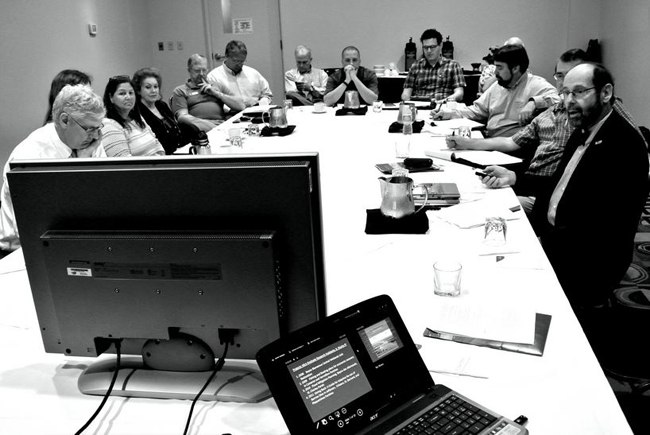
The week-long visit ended with a panel discussion and question and answer session covering a variety of recovery topics. Pictured from left are: Mark Davis, Tulane University Law School; Lauren Land, Louisiana Sea Grant sustainability coordinator; Carol Franze, LSG/LSU AgCenter associate extension agent; deEtte Smythe, St. Tammany Parish Department of Engineering; Maurice Wolcott, LSG/AgCenter GIS specialist; Rex Caffey, LSG/AgCenter marine Extension leader; Jim Wilkins, LSG Law & Policy Program director; Jon Miller, NJ Sea Grant; Ryan Orgera, NJ Sea Grant; Peter Rowe, NJ Sea Grant; Jay Tanski, NY Sea Grant; and Bruce Sharky, LSU landscape architecture professor.
Credit: Louisiana Sea Grant
More Info: New York Sea Grant
New York Sea Grant (NYSG), a cooperative program of Cornell University
and the State University of New York, is one of 33 university-based
programs under the National Sea Grant College Program (NSGCP) of the
National Oceanic and Atmospheric Administration (NOAA). The NSGCP
engages this network of the nation’s top universities in conducting
scientific research, education, training and extension projects designed
to foster science-based decisions about the use and conservation of our
aquatic resources. Through its statewide network of integrated
services, NYSG has been promoting coastal vitality, environmental
sustainability, and citizen awareness about the State’s marine and Great
Lakes resources since 1971.
For updates on Sea Grant activities:
www.nyseagrant.org has RSS,
Facebook,
Twitter, and
YouTube links. NYSG also offers a free e-list sign up via
www.nyseagrant.org/coastlines for
NY Coastlines, its flagship publication, which, in 2014, merges with the program's e-newsletter,
Currents.
NY Coastlines is published several times a year.
Web Extra: Nine Years After Katrina, Looking to Louisiana for a Path to Sandy Recovery
By Daniel Nee, Toms River Patch
New Jersey researchers explore lessons learned by Gulf Coast residents
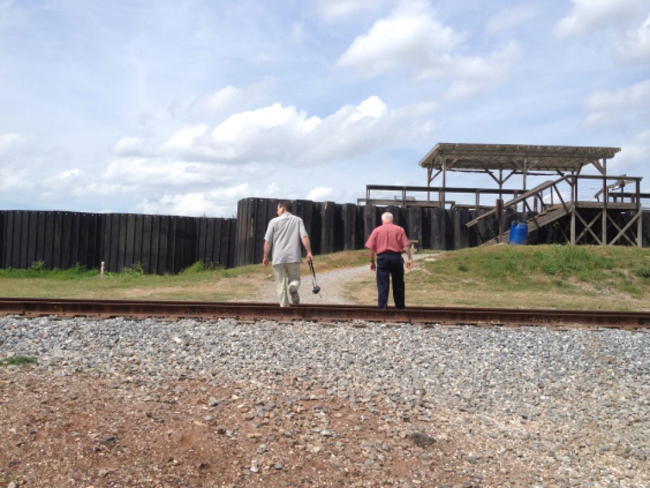 Photo Credit: Toms River Patch
Photo Credit: Toms River Patch
Toms River, NJ, May 16, 2014 - Reinventing lives and livelihoods, rebuilding homes and expressing frustration over red tape, endless government regulations and squandered recovery funding.
More than 18 months after Superstorm Sandy rolled ashore, there likely hasn't been a day that Jersey Shore residents haven't had the storm on their minds.
In Delcambre, Louisiana, it's been that way for almost nine years.
"It’s nine years and they’re still working on permitting and dredging and making connections," said Dr. Peter Rowe, the research director at the New Jersey Sea Grant Consortium.
Rowe and two colleagues from Sea Grant visited Delcambre and other cities in Louisiana, including New Orleans, last week to get a sense of what nine years of recovery looks like after Hurricane Katrina destroyed Gulf Coast communities.
Community Comes First in Recovery
For those affected by Katrina, "It’s the same issue: getting money," said Rowe. "People say the money’s there, but it never flows. I heard from many people that the squeaky wheel gets the grease, and you have to keep hammering."
Despite the lingering destruction, Delcambre is something of a success story, but only because its local business community was able to adapt. A fishing town that depends on the shrimp and oyster catch for jobs, the community largely banned together to redevelop itself – instead of relying on top-down advice from the state or federal governments.
"They emphasized that every time they used a top-down approach, it failed," said Dr. Ryan Orgera, Coastal Community Resilience Project Manager at New Jersey Sea Grant. "Louisiana is much larger than New Jersey, and sparsely populated, so at first it was hard to see how the two are similar. But the idea that the communities have to be in charge was the biggest lesson learned."
In Delcambre, an old marina destroyed during Sandy was turned into a new fishing port, and the local fishermen started a new sales approach: using Twitter and social media to post the day's catch and directly selling to consumers at the improved dock.
The idea to adapt to a new, post-storm culture wasn't easy, said Dr. Jon Miller of Stevens Institute of Technology, who also serves as Sea Grant's Coastal Processes Specialist.
"Communities had started down certain paths, realizing they were never going to get to their completion level," said Miller. But if they could get 10 percent built, they knew they would have a better case to get the money to continue the project. One thing I heard, they did a lot of what they called cussin' and discussin'."
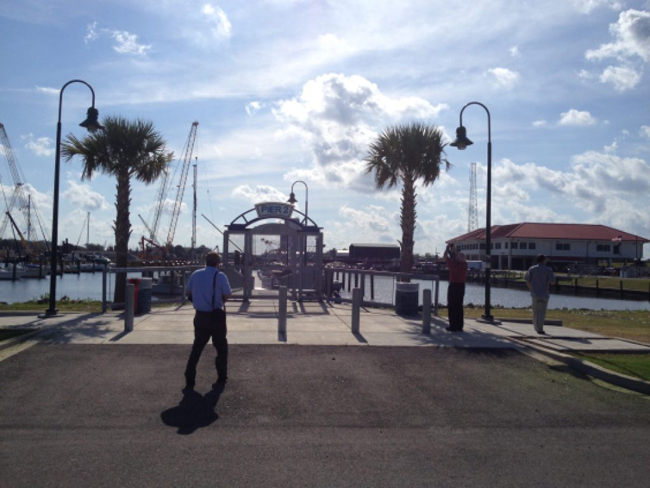 Photo Credit: Toms River Patch
A Different Kind of Shore
Photo Credit: Toms River Patch
A Different Kind of Shore
The redevelopment of Delcambre, and the bottom-up approach from its residents, may not be as easy to accomplish in New Jersey.
"A lot of our coastal communities, in particular, are not those tight-knit communities," said Miller. "You have the residents, you have summer homes, it’s all over the place."
Add in the fact that New Jersey's sting from Sandy affected towns from ultra-affluent Mantoloking to middle class Brick and Toms River, to urban areas such as Jersey City and Hoboken, and there are many competing interests, none of which see recovery in the same light, the experts said.
But the key in recovery, the Louisianans said, has to begin at the local level regardless of what defines local in a given area.
"Making new uses of old places was something they did that worked," said Rowe. "Where people took ownership and went right at it, they saw some success."
The advice that was given: "Get together with your community, meet and meet and meet, figure things out and get the support of your community so you can lean on each other and you’re not on your own," said Rowe.
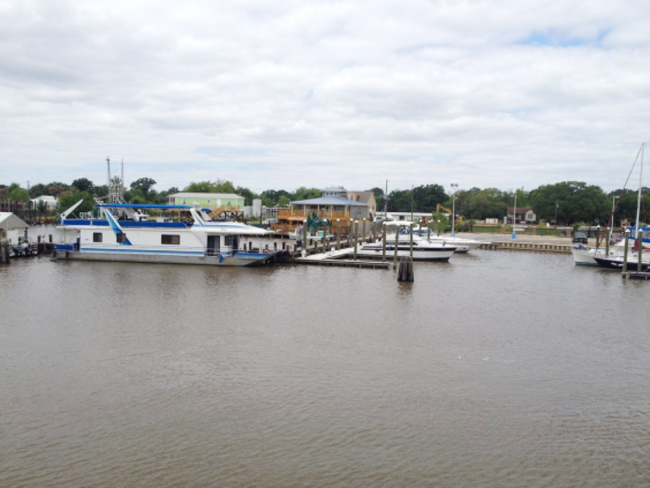 Photo Credit: Toms River Patch
A Long Road
Photo Credit: Toms River Patch
A Long Road
The success in Delcambre, of course, is tempered by areas of the city of New Orleans – including the infamous Lower Ninth Ward – which are still home to empty lots and overgrown commercial areas. Some blocks are ghost towns.
In other areas, the storm led to gentrification when developers bought up areas to make them more upscale – a scaled-down version of what many middle class Shore residents feel could become of their homes if developers and wealthy seasonal residents increase home values, especially on the barrier islands.
That makes it even more important for local residents to come up with solid plans for recovery, rebuilding and rezoning.
"The end result wasn’t, ‘do this, A, B, C.’" said Rowe, of the group's visit. "There wasn’t a silver bullet. In the longer view, it was a philosophy of moving forward as a community."
Some similarities cross all geographic and monetary bounds, however.
"They were completely frustrated with that whole process," explained Miller. "People saw how much money was wasted on bureaucracy – determining which application was better, which ones had technicalities that got them denied, it was very frustrating."
"FEMA was universally reviled by pretty much everyone down there," added Orgera.
If, aside from developing solid, local plans for rebuilding, there was one lesson learned from Katrina, it's that recovery is a long and painful road.
"There are going to be pitfalls, starts and stops," said Rowe. "Someone mentioned that after Andrew, the last FEMA field office didn’t leave for 20 years. It’s a long, drawn-out process."